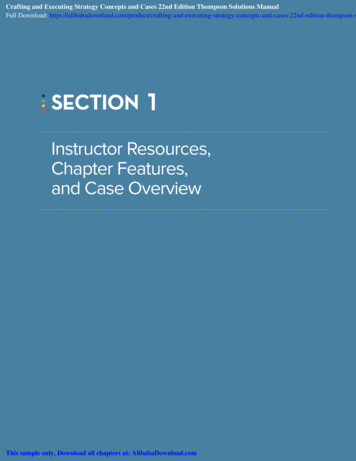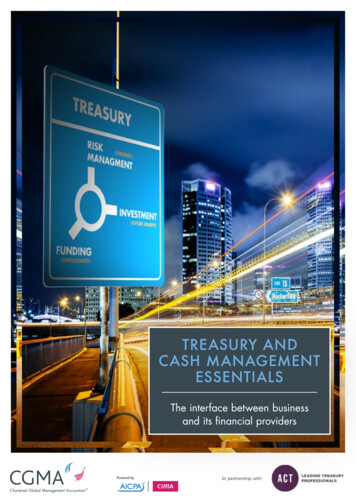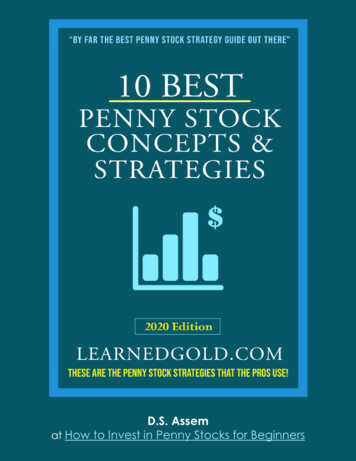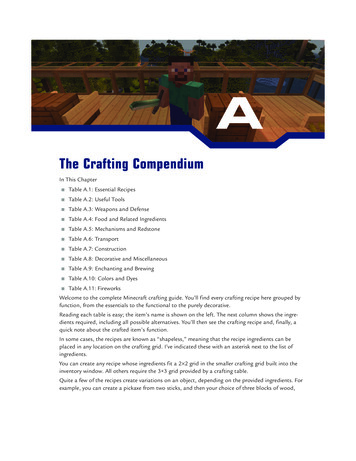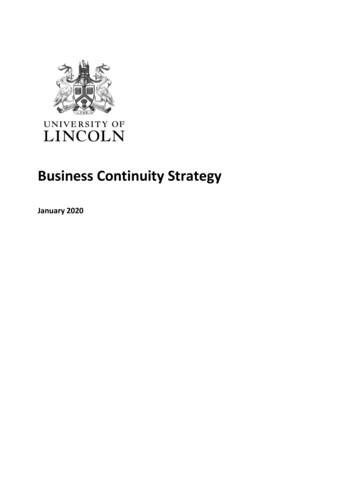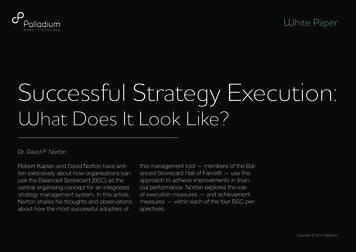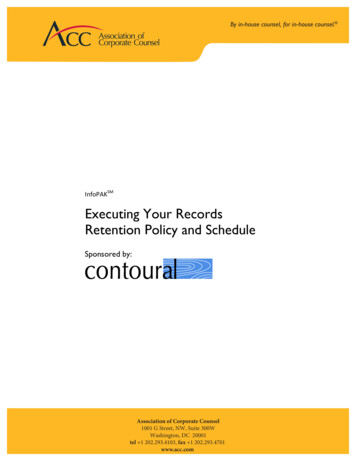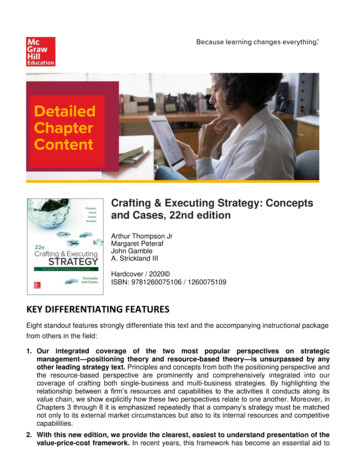
Transcription
Crafting & Executing Strategy: Conceptsand Cases, 22nd editionArthur Thompson JrMargaret PeterafJohn GambleA. Strickland IIIHardcover / 2020 ISBN: 9781260075106 / 1260075109KEY DIFFERENTIATING FEATURESEight standout features strongly differentiate this text and the accompanying instructional packagefrom others in the field:1. Our integrated coverage of the two most popular perspectives on strategicmanagement—positioning theory and resource-based theory—is unsurpassed by anyother leading strategy text. Principles and concepts from both the positioning perspective andthe resource-based perspective are prominently and comprehensively integrated into ourcoverage of crafting both single-business and multi-business strategies. By highlighting therelationship between a firm’s resources and capabilities to the activities it conducts along itsvalue chain, we show explicitly how these two perspectives relate to one another. Moreover, inChapters 3 through 8 it is emphasized repeatedly that a company’s strategy must be matchednot only to its external market circumstances but also to its internal resources and competitivecapabilities.2. With this new edition, we provide the clearest, easiest to understand presentation of thevalue-price-cost framework. In recent years, this framework has become an essential aid to
teaching students how companies create economic value in the course of conducting business.We show how this simple framework informs the concept of the business model as well as theall-important concept of competitive advantage. In Chapter 5, we add further clarity by showingin pictorial fashion how the value-price-cost framework relates to the different sources ofcompetitive advantage that underlie the five generic strategies.3. Our coverage of cooperative strategies and the role that interorganizational activity canplay in the pursuit of competitive advantage, is similarly distinguished. The topics of thevalue net, ecosystems, strategic alliances, licensing, joint ventures, and other types ofcollaborative relationships are featured prominently in a number of chapters and are integratedinto other material throughout the text. We show how strategies of this nature can contribute tothe success of single-business companies as well as multi-business enterprises, whether withrespect to firms operating in domestic markets or those operating in the international realm.4. The attention we give to international strategies, in all their dimensions, make this textbook an indispensable aid to understanding strategy formulation and execution in anincreasingly connected, global world. Our treatment of this topic as one of the most criticalelements of the scope of a company’s activities brings home to students the connection betweenthe topic of international strategy with other topics concerning firm scope, such as multi-business(or corporate) strategy, outsourcing, insourcing, and vertical integration.5. With a standalone chapter devoted to this topic, our coverage of business ethics,corporate social responsibility, and environmental sustainability goes well beyond thatoffered by any other leading strategy text. Chapter 9, “Ethics, Corporate SocialResponsibility, Environmental Sustainability, and Strategy,” fulfills the important functions of (1)alerting students to the role and importance of ethical and socially responsible decision makingand (2) addressing the accreditation requirement of the AACSB International that businessethics be visibly and thoroughly embedded in the core curriculum. Moreover, discussions of theroles of values and ethics are integrated into portions of other chapters, beginning with the firstchapter, to further reinforce why and how considerations relating to ethics, values, socialresponsibility and sustainability should figure prominently into the managerial task of craftingand executing company strategies.6. The case collection in the 22nd edition is truly unrivaled from the standpoints of studentappeal, teachability, and suitability for drilling students in the use of the concepts andanalytical treatments in Chapters 1 through 12. The 32 cases included in this edition are thevery latest, the best, and the most on target that we could find. The ample information about thecases in the Instructor’s Manual makes it effortless to select a set of cases each term that willcapture the interest of students from start to finish.7. The text is now more tightly linked McGraw-Hill’s trailblazing web-based assignmentand assessment platform called Connect . This will enable professors to gauge classmembers’ prowess in accurately completing (a) selected chapter-end exercises, (b) chapterend quizzes, and (c) the creative author-developed exercises for seven of the cases in thisedition.8. Two cutting-edge and widely used strategy simulations—The Business Strategy Gameand GLO-BUS—are optional companions to the 22nd edition. These give you anunmatched capability to employ a text-case-simulation model of course delivery.
Chapter by Chapter Details on the Organization, Content, and FeaturesChapter 1 serves as a brief, general introduction to the topic of strategy, focusing on the centralquestions of “What is strategy?” and “Why is it important?” Using the newly added example of Apple,Inc., to drive home the concepts in this chapter, we introduce students to what we mean by“competitive advantage” and the key features of business-level strategy. Describing strategy makingas a process, we explain why a company’s strategy is partly planned and partly reactive and why astrategy tends to co-evolve with its environment over time. We discuss the importance of ethics inchoosing among strategic alternatives and introduce the concept of a business model. We show thata viable business model must provide both an attractive value proposition for the company’scustomers and a formula for making profits for the company. A key feature of this chapter is adepiction of how the value-price-cost framework can be used to frame this discussion. We show howthe mark of a winning strategy is its ability to pass three tests: (1) the fit test (for internal and externalfit), (2) the competitive advantage test, and (3) the performance test. And we explain why good company performance depends not only upon a sound strategy but upon solid strategy execution as well.Chapter 2 presents a more complete overview of the strategic management process, covering topicsranging from the role of vision, mission, and values to what constitutes good corporate governance.It introduces students to such core concepts as strategic versus financial objectives, the balancedscorecard, strategic intent, and business-level versus corporate-level strategies. It explains why allmanagers are on a company’s strategy-making, strategy-executing team and why a company’sstrategic plan is a collection of strategies devised by different managers at different levels in theorganizational hierarchy. The chapter concludes with a section on the role of the board of directorsin the strategy-making, strategy-executing process and examines the conditions that have led torecent high-profile corporate governance failures. The illustration capsule on Volkswagen’semissions scandal brings this section to life.Chapter 3 and 4 introduce students to the two most fundamental perspectives on strategy making:the positioning view, exemplified by Michael Porter’s “five forces model of competition”; and theresource-based view. Chapter 3 provides what has long been the clearest, most straightforwarddiscussion of the five forces framework to be found in any text on strategic management. It alsooffers a set of complementary analytical tools for conducting competitor analysis, identifying strategicgroups along with the mobility barriers that limit movement among them, and demonstrates theimportance of tailoring strategy to fit the circumstances of a company’s industry and competitiveenvironment. The chapter includes a discussion of the value net framework, which is useful forconducting analysis of how cooperative as well as competitive moves by various parties contributeto the creation and capture of value in an industry.Chapter 4 presents the resource-based view of the firm, showing why resource and capabilityanalysis is such a powerful tool for sizing up a company’s competitive assets. It offers a simpleframework for identifying a company’s resources and capabilities and explains how the VRINframework can be used to determine whether they can provide the company with a sustainablecompetitive advantage over its competitors. Other topics covered in this chapter include dynamiccapabilities, SWOT analysis, value chain analysis, benchmarking, and competitive strengthassessments, thus enabling a solid appraisal of a company’s cost position and customer valueproposition vis-á-vis its rivals. An important feature of this chapter is a table showing how key
financial and operating ratios are calculated and how to interpret them. Students will find this tablehandy in doing the number crunching needed to evaluate whether a company’s strategy is deliveringgood financial performance.Chapter 5 sets forth the basic approaches available for competing and winning in the marketplacein terms of the five generic competitive strategies—broad low-cost, broad differentiation, best-cost,focused differentiation, and focused low cost. It demonstrates pictorially the link between genericstrategies, the value-price-cost framework, and competitive advantage. The chapter also describeswhen each of the five approaches works best and what pitfalls to avoid. Additionally, it explains therole of cost drivers and uniqueness drivers in reducing a company’s costs and enhancing itsdifferentiation, respectively.Chapter 6 focuses on other strategic actions a company can take to complement its competitiveapproach and maximize the power of its overall strategy. These include a variety of offensive ordefensive competitive moves, and their timing, such as blue-ocean strategies and first-moveradvantages and disadvantages. It also includes choices concerning the breadth of a company’sactivities (or its scope of operations along an industry’s entire value chain), ranging from horizontalmergers and acquisitions, to vertical integration, outsourcing, and strategic alliances. This materialserves to segue into the scope issues covered in the next two chapters on international and diversification strategies.Chapter 7 takes up the topic of how to compete in international markets. It begins with a discussionof why differing market conditions across countries must necessarily influence a company’s strategicchoices about how to enter and compete in foreign markets. It presents five major strategic optionsfor expanding a company’s geographic scope and competing in foreign markets: export strategies,licensing, franchising, establishing a wholly owned subsidiary via acquisition or “greenfield” venture,and alliance strategies. It includes coverage of topics such as Porter’s Diamond of NationalCompetitive Advantage, multi-market competition, and the choice between multi-domestic, global,and transnational strategies. This chapter explains the impetus for sharing, transferring, or accessingvaluable resources and capabilities across national borders in the quest for competitive advantage,connecting the material to that on the resource-based view from Chapter 4. The chapter concludeswith a discussion of the unique characteristics of competing in developing-country markets.Chapter 8 concerns strategy making in the multi-business company, introducing the topic ofcorporate-level strategy with its special focus on diversification. The first portion of this chapterdescribes when and why diversification makes good strategic sense, the different means ofdiversifying a company’s business lineup, and the pros and cons of related versus unrelateddiversification strategies. The second part of the chapter looks at how to evaluate the attractivenessof a diversified company’s business lineup, how to decide whether it has a good diversificationstrategy, and what strategic options are available for improving a diversified company’s futureperformance. The evaluative technique integrates material concerning both industry analysis andthe resource-based view, in that it considers the relative attractiveness of the various industries thecompany has diversified into, the company’s competitive strength in each of its lines of business,and the extent to which its different businesses exhibit both strategic fit and resource fit.
Chapter 9 brings more direct attention to such issues and may be used as a stand-aloneassignment in either the early, middle, or late part of a course. It concerns the themes of ethicalstandards in business, approaches to ensuring consistent ethical standards for companies withinternational operations, corporate social responsibility, and environmental sustainability. Thecontents of this chapter are sure to give students some things to ponder, rouse lively discussion,and help to make students more ethically aware and conscious of why all companies should conducttheir business in a socially responsible and sustainable manner.Chapters 10, 11, and 12 comprise a module on strategy execution that is presented in terms of a10 step action framework.Chapter 10 provides an overview of this framework and then explores the first three of these tasks:(1) Staffing the organization with people capable of executing the strategy well, (2) building theorganizational capabilities needed for successful strategy execution, and (3) creating anorganizational structure supportive of the strategy execution process.Chapter 11 discusses five additional managerial actions that advance the cause of good strategyexecution: (1) allocating resources to enable the strategy execution process, (2) ensuring thatpolicies and procedures facilitate rather than impede strategy execution, (3) using processmanagement tools and best practices to drive continuous improvement in the performance of valuechain activities, (4) installing information and operating systems that help company personnel carryout their strategic roles, and (5) using rewards and incentives to encourage good strategy executionand the achievement of performance targets.Chapter 12 completes the 10-step framework with a consideration of the importance of creating ahealthy corporate culture and exercising effective leadership in promoting good strategy execution.The recurring theme throughout the final three chapters is that executing strategy involves decidingon the specific actions, behaviors, and conditions needed for a smooth strategy-supportive operationand then following through to get things done and deliver results. The goal here is to ensure thatstudents understand that the strategy-executing phase is a make-things-happen and make-themhappen-right kind of managerial exercise—one that is critical for achieving operating excellence andreaching the goal of strong company performance.
CASE TABLE OF CONTENTSSection A: CRAFTING STRATEGY IN SINGLE BUSINESS COMPANIES1 Mystic Monk Coffee2 Airbnb in 20183 Wil’s Grill4 Costco Wholesale in 2018: Mission, Business Model, and Strategy5 Competition in the Craft Beer Industry in 20186 Fixer Upper: Expanding the Magnolia Brand7 Under Armour’s Turnaround Strategy in 2018--Efforts to Revive North American Sales andProfitability Market for Sports Apparel and Footwear?8 MoviePass--Are Subscribers Loving it to Death?9 TOMS Shoes--Expanding its Successful One for One Business Model10 Lola’s Market--Capturing a New Generation11 iRobot in 2018--Can the Company Keep the Magic?12 Chipotle Mexican Grill’s Strategy in 2018--Will the New CEO Be Able to Rebuild Customer Trustand Revive Sales Growth?13 Twitter, Inc. in 2018--Too Little Too Late?14 Netflix’s Strategy in 2018--Does the Company Have Sufficient Competitive Strength to Fight OffAggressive Rivals?15 Walmart’s Expansion into Specialty Online Retailing16 Amazon.com Inc.--Driving Disruptive Change in the U.S. Grocery Market17 Aliexpress--Can it Mount a Global Challenge to Amazon?18 Tesla Motors in 2018--Will the New Model 3 Save the Company?19 Mattel, Incorporated in 2018--Can Ynon Kreiz Save the Toys?20 Shearwater Adventures Ltd.21 TJX Companies--Its Strategy in Off-Price Home Accessories and Apparel Retailing22 IKEA’s International Marketing Strategy in ChinaSection B: CRAFTING STRATEGY IN DIVERSIFIED COMPANIES23 PepsiCo’s Diversification Strategy in 2018--Will the Company’s New Businesses Restore itsGrowth?24 The Walt Disney Company--Its Diversification Strategy in 2018Section C: IMPLEMENTING AND EXECUTING STRATEGY25 Robin Hood26 Dilemma at Devil’s Den27 Nucor Corporation in 2018: Contending with the Challenges of Low-Cost Foreign Imports andWeak Demand for Steel Products28 Vail Resorts, Inc.29 Starbucks in 2018--Striving for Operational Excellence and Innovation AgilitySection D: STRATEGY, ETHICS, AND SOCIAL RESPONSIBILITY30 Concussions in Collegiate and Professional Football-- Who Has Responsibility to Protect Players?31 Chaos at Uber--The New CEO’s Challenge32 Profiting from Pain--Business and the U.S. Opioid EpidemicGUIDE TO CASE ANALYSIS
Crafting & Executing Strategy: Concepts and Cases, 22nd edition Arthur Thompson Jr Margaret Peteraf John Gamble A. Strickland III Hardcover / 2020 ISBN: 9781260075106 / 1260075109 . Eight standout features strongly differentiate this text and the accomp

